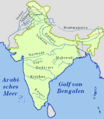Indian subcontinent
![]()
This article or subsequent section is not sufficiently supported by evidence (e.g., anecdotal evidence). Information without sufficient evidence may be removed in the near future. Please help Wikipedia by researching the information and adding good supporting evidence.
The Indian subcontinent is the land mass south of the Himalayas and a part of South Asia. Most of the region is occupied by the Indian territory, other states with territorial shares of the subcontinent are Bangladesh, Bhutan, Nepal, Pakistan and Sri Lanka. Geographically, the Indian subcontinent can also be described by the two rivers Indus and Ganges as natural boundaries; the namesake Indus, at 3,180 km, is the longest river in the subcontinent, and is the most important river in Pakistan; the Ganges (2,511 km long) is the most important river in India and Bangladesh.
·
Rivers on the subcontinent
· 
The Indian subcontinent with state borders
This region is called a "subcontinent" because the landmass is not part of the Eurasian Plate, but part of the Indian Plate. In Earth's history, this landmass was part of a lithospheric plate that broke away from the great continent of Gondwana and moved northward from the southern hemisphere. As a result of the collision with the Eurasian Plate, the Himalayas unfolded and a land connection with Asia occurred.

Chronological course of the shift of the Indian subcontinent
Questions and Answers
Q: What is the Indian subcontinent?
A: The Indian subcontinent is a geographic region which includes Bangladesh, Bhutan, Republic of India, Maldives, Nepal, Pakistan and Sri Lanka. It is south of the Himalayas and was once part of Gondwana, an ancient southern supercontinent.
Q: How were the Himalayas formed?
A: The Himalayas were formed when the Indian tectonic plate travelled northward at 15 cm per year to slowly squeeze the Eurasian continent about 40-50 million years ago. This process caused the rock of seabeds from that time to be uplifted into mountains.
Q: What happened to the Tethys Ocean?
A: About 50 million years ago, this fast moving plate had completely closed off the Tethys Ocean. Evidence for its existence can be found in sedimentary rocks settled on its ocean floor and volcanoes that fringed its edges.
Q: How fast is the Indo-Australian plate moving?
A: The Indo-Australian plate is currently moving at 67 mm per year. Over the next 10 million years it may travel about 1,500 km into Asia.
Q: How does this movement affect the Himalayas?
A: About 20 mm per year of India-Asia convergence is absorbed by thrusting along the Himalaya southern front which leads to them rising by about 5 mm per year making them geologically active.
Q: What other effects does this movement have?
A: This movement also causes earthquakes from time to time due to pressure being put on land masses as they move towards each other.
Search within the encyclopedia
